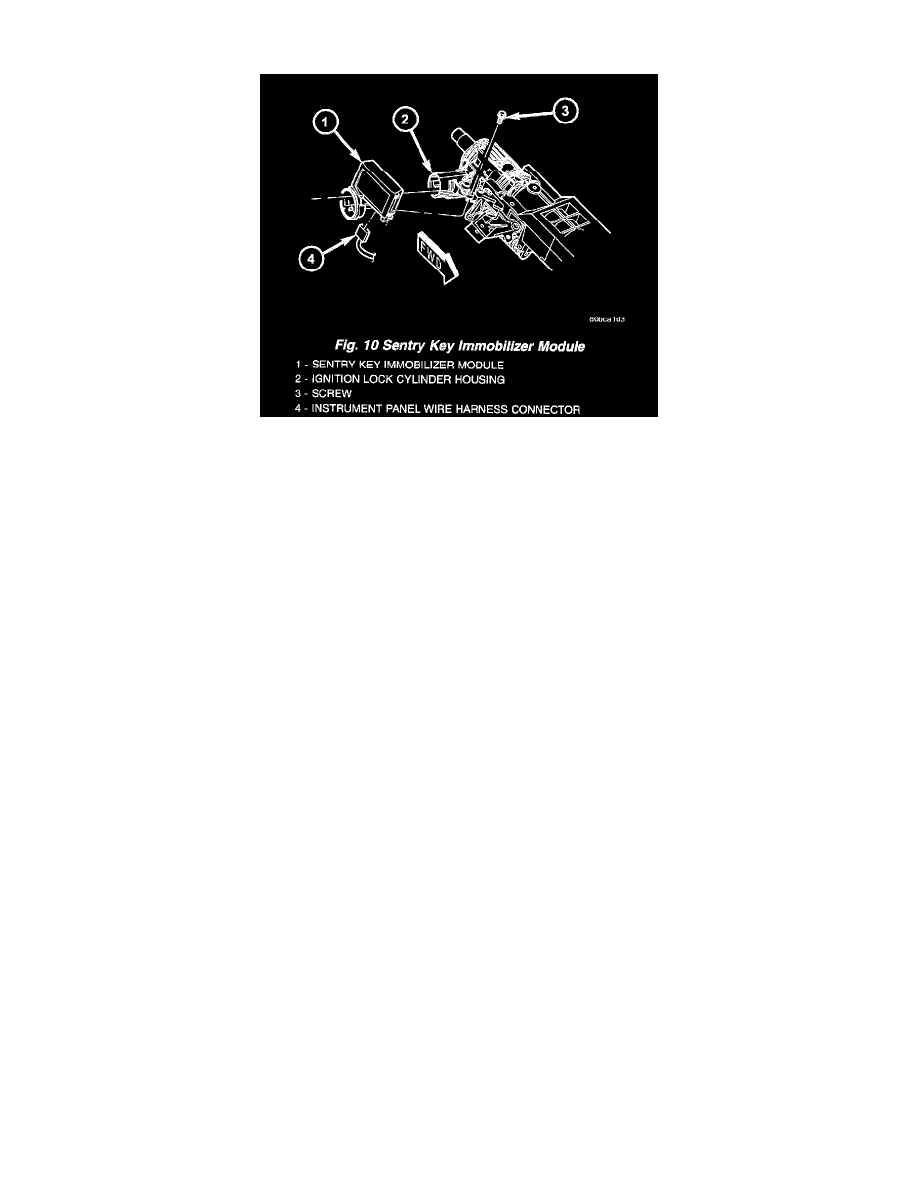Dakota Quad Cab 4WD V6-3.9L VIN X (2001)

Alarm Module: Description and Operation
Fig.10 Sentry Key Immobilizer Module
SENTRY KEY IMMOBILIZER MODULE
The Sentry Key Immobilizer Module (SKIM) is the primary component of the Sentry Key Immobilizer System (SKIS). The SKIM is located on
the right side of the steering column, near the ignition lock cylinder housing and is concealed beneath the steering column shrouds. The molded
black plastic housing for the SKIM has an integral molded plastic halo-like antenna ring that extends from one side. When the SKIM is properly
installed on the steering column, the antenna ring is oriented around the circumference of the ignition lock cylinder housing. A single integral
connector receptacle containing six terminal pins is located on the opposite end of the SKIM housing from the antenna ring. A molded plastic
mounting tab that is integral to the SKIM housing has a hole in the center through which a screw passes to secure the unit to the steering column.
The SKIM is connected to the vehicle electrical system through a single take out and connector of the instrument panel wire harness.
The SKIM cannot be adjusted or repaired. If faulty or damaged, the entire SKIM unit must be replaced.
The Sentry Key Immobilizer Module (SKIM) contains a Radio Frequency (RF) transceiver and a microprocessor. The SKIM transmits RF signals
to, and receives RF signals from the Sentry Key transponder through a tuned antenna enclosed within the molded plastic antenna ring integral to
the SKIM housing. If this antenna ring is not mounted properly around the ignition lock cylinder housing, communication problems between the
SKIM and the transponder may arise. These communication problems will result in Sentry Key transponder-related faults. The SKIM also
communicates over the Programmable Communications Interface PCI data bus with the Powertrain Control Module (PCM), the Central Timer
Module (CTM), and/or the DRB III scan tool.
The SKIM retains in memory the JD numbers of any Sentry Key transponder that is programmed into it. A maximum of eight Sentry Key
transponders can be programmed into the SKIM. For added system security, each SKIM is programmed with a unique Secret Key code. This code
is stored in memory, sent over the PCI data bus to the PCM, and is encoded to the transponder of every Sentry Key that is programmed into the
SKIM. Therefore, the Secret Key code is a common element that is found in every component of the Sentry Key Immobilizer System (SKIS).
Another security code, called a PIN, is used to gain access to the SKIM Secured Access Mode. The Secured Access Mode is required during
service to perform the SKIS initialization and Sentry Key transponder programming procedures. The SKIM also stores the Vehicle Identification
Number (VIN) in its memory, which it learns through a PCI data bus message from the PCM during SKIS initialization.
In the event that a SKIM replacement is required, the Secret Key code can be transferred to the new SKIM from the PCM using the DRB III scan
tool and the SKIS initialization procedure. Proper completion of the SKIS initialization will allow the existing Sentry Keys to be programmed into
the new SKIM so that new keys will not be required. In the event that the original Secret Key code cannot be recovered, SKIM replacement will
also require new Sentry Keys. The DRB III scan tool will alert the technician during the SKIS initialization procedure if new Sentry Keys are
required.
When the ignition switch is turned to the ON position, the SKIM transmits an RF signal to the transponder in the ignition key. The SKIM then
waits for an RF signal response from the transponder. If the response received identifies the key as valid, the SKIM sends a valid key message to
the PCM over the PCI data bus. If the response received identifies the key as invalid, or if no response is received from the key transponder, the
SKIM sends an invalid key message to the PCM. The PCM will enable or disable engine operation based upon the status of the SKIM messages. It
is important to note that the default condition in the PCM is an invalid key; therefore, if no message is received from the SKIM by the PCM, the
engine will be disabled and the vehicle immobilized after two seconds of running.
The SKIM also sends security indicator status messages to the CTM over the PCI data bus to tell the CTM how to operate the security indicator.
